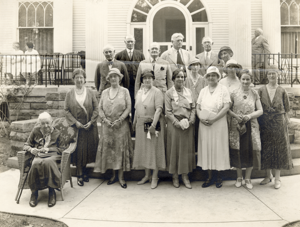Fannie Rosalind Hicks Givens facts for kids
Quick facts for kids
Fannie Rosalind Hicks Givens
|
|
|---|---|
| Born | May 29, 1861 Sturgeon, Missouri, US
|
| Died | August 4, 1947 Louisville, Kentucky, US
|
| Occupation | Artist, political activist, policewoman |
Fannie Rosalind (Hicks) Givens (May 29, 1861 – August 4, 1947) was an artist, missionary, and political activist. Mainly a resident of Louisville, Kentucky, she created and taught art in many forms including painting and poetry and served as a policewoman for the city. Hicks was politically active in many different organizations, traveling around the world to advocate for Black and women's rights.
Early life
Fannie R. Hicks was born on May 29, 1861, in Sturgeon, Missouri. However, there are several dates listed on her documents such as her death certificate listing 1876 and her headstone listing 1864. As a young child, she and her parents moved to Louisville, Kentucky. It is speculated that her parents were both enslaved before "migrating north."
On June 27, 1895, Hicks married James Edward Givens, a Harvard graduate and professor at State University, now known as Simmons College of Kentucky. Hicks took her husband's name, becoming publicly known as Fannie R. Givens. Although the couple never had children of their own, the couple adopted James' niece and the fostered the four remaining siblings.
Education
Givens attended high school in St. Louis and Chicago, although it is unknown which schools. Givens attended Knox College and graduated in 1892, popularly believed to be the first Black woman to graduate from the school of art. At the time, she listed her residence as Colorado Springs, Colorado. She also attended State University, Louisville Municipal College, and took a "correspondence course," as Givens describes, at Henry George School of Social Science NYC.
Career and art
After graduating from Knox, Givens returned to Louisville and served as the head of the art department at Simmons University, known at the time as State University. The department included 23 students and their art was featured in Chicago at the World's Columbian Exposition in 1893.
Givens was well known for her portraits and presented a portrait of John Lewis Waller to President Benjamin Harris. The portrait was hung in the White House. She is also known for her portrait of Booker T. Washington. Because of her interest in African art, Prince Massaquoi honored Givens as a Princess, most likely when she traveled to Liberia. Givens' life-sized portrait of a woman referred to as Mrs. Talbert was hung in the Frederick Douglass Home.
Givens taught art from her home in Louisville and was the only Black person listed as an "artist and portrait artist" in the Louisville City Directory commercial ads. She also wrote poetry and songs. Her poem "Glimpses of the Old World" was held in the Congressional Library and she wrote many more. She copyrighted the song ""Hallelujah! Christ is Risen."
Givens did a large amount of traveling in Europe and Africa for the different organizations she was involved in, including the Baptist World Alliance and the National Association of Colored Women (NACW).
The Encyclopedia Titanica website reports that while aboard the Adriatic ship, Givens was a victim of discrimination from a white passenger named H.W. McElroy. The website reports her own words where she describes the situation on the ship where, along with the food lines being separate, the five Black passengers were all given "a bad seat" with the band members. Givens along with Doctor Camphor, a fellow black passenger, defended themselves from the insulter, then Givens went on a hunger strike for the three following days, refusing to eat aboard a ship where she is treated differently than her white counterparts. Givens writes that she met with the captain on the third day for his word in writing, telling the captain she would refuse to eat where she is discriminated against for the color of her skin. This sparked a "heated discussion," among the crew members when Givens also stated that she paid the same amount of money as the white passengers, so she shouldn't be treated differently. After that day, she reports that she had no more troubles.
Givens was involved in organizations that united Black Americans, but she was also active in growing access to the arts. She was president and manager of the National Historical Art League, the head of the Art Department at State University and the head of the Kentucky Association of Colored Women. In 1918, Givens, Mary Virginia Cook Parrish, and William Spradling created an art school in a statuary hall with the National Historical Art League. Givens attempted to raise $100,000 to build an art institute for Black artists at Howard University, but unfortunately, not enough money was raised.
Being politically active in her community, Givens served as a GOP delegate from the 4th Ward beginning in 1921. In 1927, she was vocal about funding the Ohio River Bridge.
That same year, Givens became Louisville's second Black policewoman. In 1938, Givens, along with three other women, were fired by Sam H. McMeekin, who was the Safety Director and claimed the women "had no specific duties." ....." Police Chief John M. Malley dismissed the appeal.
By 1935, she was the president for The World Union of Colored Women for Peace and International Concord. September 30, 1936, the Eta Zeta chapter of Zeta Phi Beta sorority honors Givens. She was the former Grand Basileus for the sorority and is listed as a notable Zeta Phi Beta sister.
Later life and death
In 1932, Givens attended the fifty year reunion at Knox College. In Louisville, she was a member of the 5th Street Baptist Church.
On August 4, 1947, Givens died in her home at 507 E. Finzer Street in Jefferson County from breast cancer. She was buried with her husband in Eastern Cemetery and has a plaque from Zeta Phi Beta to decorate her grave.



